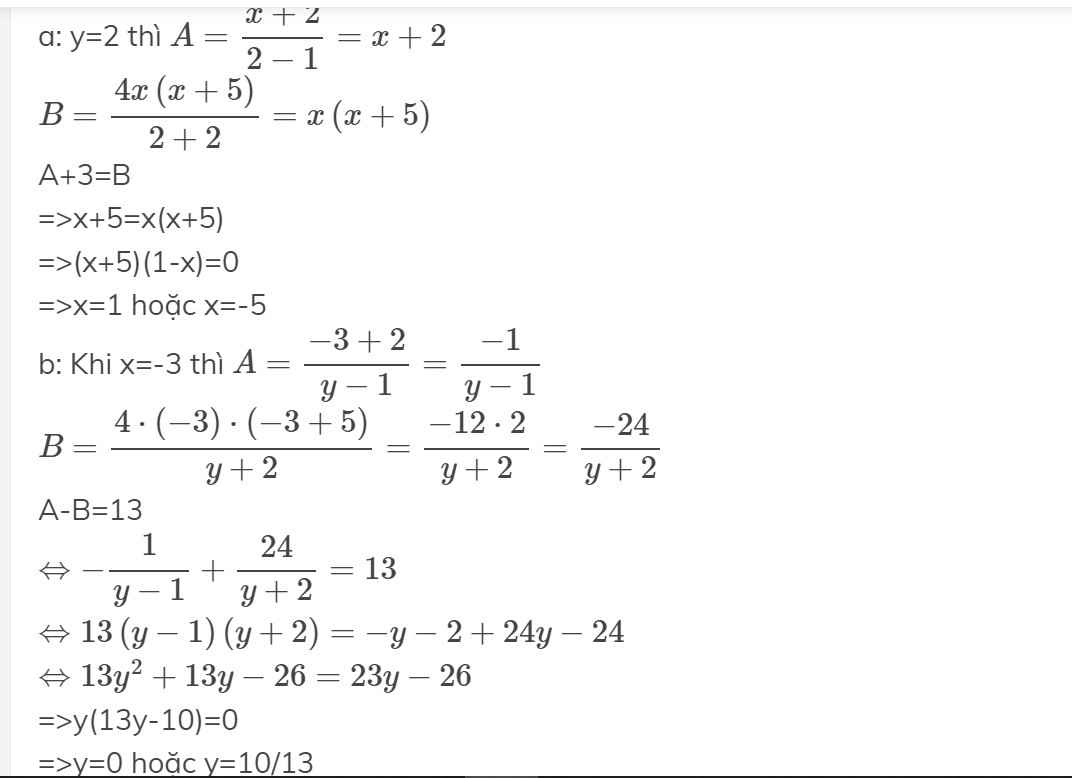giả pt x^2+1+-1
Hãy nhập câu hỏi của bạn vào đây, nếu là tài khoản VIP, bạn sẽ được ưu tiên trả lời.


\(2\left(x^2+x-1\right)^2-5\left(x^2+x-1\right)\left(x^2-x+1\right)+2\left(x^2-x+1\right)^2=0\)
Đặt \(x^2+x-1=a;x^2-x+1=b\)
\(\Leftrightarrow2a^2-5ab+2b^2=0\)
\(\Leftrightarrow2a^2-4ab-ab+2b^2=0\)
\(\Leftrightarrow\left(a-2b\right)\left(2a-b\right)=0\)
\(\Leftrightarrow\left[{}\begin{matrix}a=2b\\b=2a\end{matrix}\right.\Leftrightarrow\left[{}\begin{matrix}x^2+x-1=2x^2-2x+2\\x^2-x+1=2x^2+2x-2\end{matrix}\right.\)
\(\Leftrightarrow\left[{}\begin{matrix}-x^2+3x-3=0\\-x^2-3x+3=0\end{matrix}\right.\Leftrightarrow x^2-3x-3=0\)
\(\text{Δ}=\left(-3\right)^2-4\cdot1\cdot\left(-3\right)=9+4\cdot3=21\)
Vì Δ>0 nên phương trình có hai nghiệm phân biệt là
\(\left\{{}\begin{matrix}x_1=\dfrac{3-\sqrt{21}}{2}\\x_2=\dfrac{3+\sqrt{21}}{2}\end{matrix}\right.\)

\(\sqrt{\frac{1-x}{x}}=\frac{2x+x^2}{1+x^2}\)
\(\Leftrightarrow\sqrt{\frac{1-x}{x}}-1=\frac{2x+x^2}{1+x^2}-1\)
\(\Leftrightarrow\frac{-\left(2x-1\right)}{\sqrt{\frac{1-x}{x}}+1}-\frac{2x-1}{1+x^2}=0\)
\(\Leftrightarrow\left(2x-1\right)\left(\frac{-1}{\sqrt{\frac{1-x}{x}}+1}-\frac{1}{1+x^2}\right)=0\)
Dễ thấy: \(\frac{-1}{\sqrt{\frac{1-x}{x}}+1}-\frac{1}{1+x^2}< 0\)
\(\Rightarrow2x-1=0\Rightarrow x=\frac{1}{2}\)

ĐKXĐ: \(x\ge1\)
\(\Leftrightarrow\sqrt{x^2+x-2}-\sqrt{2x-2}+x^2-1=0\)
\(\Leftrightarrow\frac{x^2+x-2-2x+2}{\sqrt{x^2+x-2}+\sqrt{2x-2}}+\left(x-1\right)\left(x+1\right)=0\)
\(\Leftrightarrow\frac{x\left(x-1\right)}{\sqrt{x^2+x-2}+\sqrt{2x-2}}+\left(x-1\right)\left(x+1\right)=0\)
\(\Leftrightarrow\left(x-1\right)\left(\frac{x}{\sqrt{x^2+x-2}+\sqrt{2x-2}}+x+1\right)=0\)
\(\Leftrightarrow x-1=0\) (ngoặc phía sau luôn dương \(\forall x>1\))
\(\Rightarrow x=1\)

xét pt \(x^2-\left(m-1\right)x-m^2+m-1=0\) \(\left(1\right)\)
từ (1) có \(\Delta=\left[-\left(m-1\right)\right]^2-4.\left(-m^2+m-1\right)\)
\(\Delta=m^2-2m+1+4m^2-4m+4\)
\(\Delta=5m^2-6m+5\)
\(\Delta=5\left(m^2-\frac{6}{5}m+1\right)\)
\(\Delta=5\left[m^2-2.\frac{3}{5}m+\frac{9}{25}-\frac{9}{25}+1\right]\)
\(\Delta=5\left[\left(m-\frac{3}{5}\right)^2+\frac{16}{25}\right]>0\forall m\)
\(\Rightarrow pt\left(1\right)\) luôn có 2 nghiệm phân biệt \(\forall m\)
ta có vi - ét \(\hept{\begin{cases}x_1+x_2=m-1\\x_1.x_2=-m^2+m-1\end{cases}}\)
theo bài ra \(\left|x_2\right|-\left|x_1\right|=2\)
\(\Leftrightarrow\left(\left|x_1\right|+\left|x_2\right|\right)=4\)
\(\Leftrightarrow x_1^2+x_2^2+2\left|x_1.x_2\right|=4\)
\(\Leftrightarrow\left(x_1+x_2\right)^2-2x_1.x_2+2\left|x_1.x_2\right|=4\)
\(\Leftrightarrow\left(m-1\right)^2-2\left(-m^2+m-1\right)+2\left|x_1.x_2\right|=4\)
\(\Leftrightarrow m^2-2m+1+2m^2-2m+2+2\left|x_1.x_2\right|=4\)
\(\Leftrightarrow3m^2-4m+3+2\left|x_1.x_2\right|=4\)
cái này đến đây xét ra 2 trường hợp rồi đối chiếu với ĐKXĐ là xong

a.Thay p=3 vào pt ta có:
x2+3x-4=0 mà a+b+c=0 thì ta có 2 ng là 1 và -4
b.theo viet ta có x1+x2=-p/2 và x1.x2=-4
nên từ gt đã cho ta có x1.x22+x1+x22+x2>6
x1.x2(x1+x2)+x1+x2>6
2p+(-p/2)>6
3p>12
p>4

Theo Viet: \(x_1+x_2=-2\left(m-2\right)\)
Do \(ac=-m^2-5< 0\) \(\forall m\Rightarrow\) pt luôn luôn có 2 nghiệm trái dấu
Mà \(x_1< x_2\Rightarrow\left\{{}\begin{matrix}x_1< 0\\x_2>0\end{matrix}\right.\) \(\Rightarrow\left\{{}\begin{matrix}\left|x_1\right|=-x_1\\\left|x_2+1\right|=x_2+1\end{matrix}\right.\)
\(\left|x_1\right|-\left|x_2+1\right|=5\)
\(\Leftrightarrow-x_1-x_2-1=5\)
\(\Leftrightarrow x_1+x_2=-6\)
\(\Leftrightarrow-2\left(m-2\right)=-6\Rightarrow m=5\)

x2 + 1 + (-1) = 0
=>x2 = 0
=> x = 0
Vậy x = 0